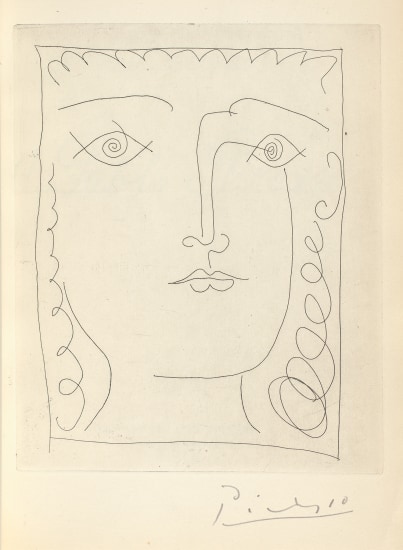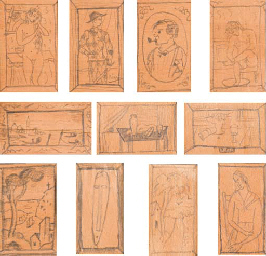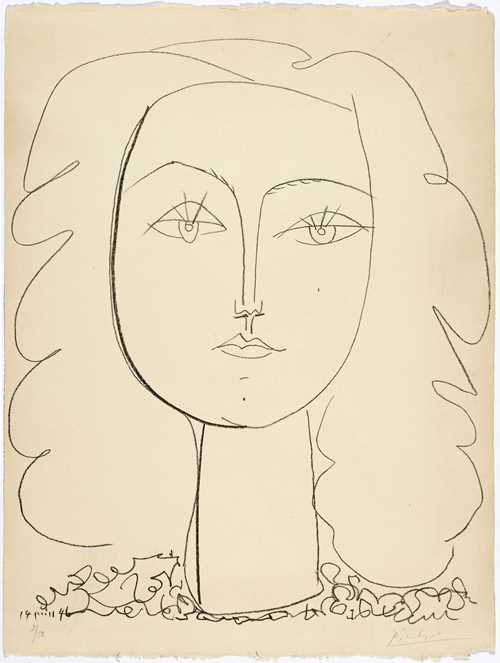Pablo Picasso (Spanish, 1881-1973) La Suite des Saltimbanques (Bloch 1-15; Baer 2-7, 9-15, 17, 18) The rare complete suite of 15 etchings and drypoints, 1904-05, fine impressions from the edition of 250 on van Gelder Zonen wove paper, with the exception of Le Saltimbanque au repos (B. 10), one of 27 or 29 proofs on Japan laid paper and signed in red crayon, published by Ambroise Vollard and printed by Fort in 1913, Paris, all with wide margins or the full sheets, in good condition Largest sheet (Repas Frugal) 650 x 505mm. (25 1/2 x 19 7/8in.) Fußnoten Provenance: Les Pauvres (B. 3) with collector's mark of Marcel Louis Guérin (1873-1948), Paris (Lugt 1872b). Le Saltimbanque au Repos (B. 10), with the Leicester Galleries, London; John Richardson by whom given to Douglas Cooper at Christmas, 1950; Acquired by the present owner from the Douglas Cooper Collection sale at Christie's London, 30 November 1988, lot 542. La Danse Barbare (B. 15), with collector's mark of Henri Petiet verso (Lugt 5031). La Suite des Saltimbanques comprises : Le Repas Frugal (B. 1; Ba. 2) Tête de Femme (B. 2; Ba. 3) Les Pauvres (B. 3; Ba. 4) Buste d'Homme (B. 4; Ba. 5) Les Deux Saltimbanques (B. 5; Ba. 6) Tête de Femme, de Profil (B. 6; Ba. 7) Les Saltimbanques (B. 7; Ba. 9) L'Abreuvoir (B. 8; Ba. 10) Au Cirque (B. 9; Ba. 11) Le Saltimbanques au Repos (B. 10; Ba. 12) La Famille de Saltimbanques au Macaque (B. 11; Ba. 13) Le Bain (B. 12; Ba. 14) La Toilette de la Mère (B. 13; Ba. 15) Salomé (B. 14; Ba. 17) La Danse Barbare (B. 15; Ba. 18) The series of fifteen etchings and drypoints famously known as La Suite des Saltimbanques are Picasso's first printed works. They encompass the most important subjects that preoccupied him during the beginning of his career. Bohemianism, poverty and the theatrical world are all the themes that inspired his work during the Rose and Blue periods. In 1904, a young Picasso living in the poorest conditions at the Bateau-Lavoir in Montmartre, produced his second ever etching, and the most important and largest subject in the series, Le Repas Frugal. A famished-looking couple sitting in front of a table, empty but for a crust of bread and some wine. A symbolic still life with a reference to the sacraments on an altar cloth. The worn physical expressions of these two figures are a clear identification of the artist's life at this point in his career: moving from place to place, living a 'frugal' life. Due to his poverty, Picasso re-used a copper plate that had been previously etched by his artist friend Joan Gonzales; the traces of his ghostly landscape can still be seen in the upper part of the composition. This melancholic depiction of bohemian life constitutes one of the most important works in the graphic oeuvre of the artist. The other etchings in the series feature itinerant acrobats and harlequins. Picasso shows the performers behind the scenes, caught in the intimacy of their private moments. Some are shown rehearsing their acts and other are simply eating with their families or taking a bath. The Paris dealer and publisher Ambroise Vollard acquired the fifteen plates of the suite after the death of his neighbour and fellow dealer Clovis Sagot. Picasso had only printed a few impressions from each plate, and so Vollard decided to print an edition after having the plates steel-faced. This suite, so rarely found complete, includes also the rare subject La famille de Saltimbanques au Macaque (B. 11; Ba. 13). Vollard destroyed most of the edition due to the bad state of the copper plate. Therefore, only a few impressions have survived as it was not included when the series was commercialised. The poet and friend of Picasso, Guillaume Apollinaire wrote about this series Picasso's taste for pure lines which recedes, changes and penetrates, produced almost unique examples of linear drypoints. This set of prints had no obvious precedent, and proved not only Picasso's ability as a draftsman and printmaker, but as a gifted young a
Pablo Picasso (Spanish, 1881-1973) La Suite des Saltimbanques (Bloch 1-15; Baer 2-7, 9-15, 17, 18) The rare complete suite of 15 etchings and drypoints, 1904-05, fine impressions from the edition of 250 on van Gelder Zonen wove paper, with the exception of Le Saltimbanque au repos (B. 10), one of 27 or 29 proofs on Japan laid paper and signed in red crayon, published by Ambroise Vollard and printed by Fort in 1913, Paris, all with wide margins or the full sheets, in good condition Largest sheet (Repas Frugal) 650 x 505mm. (25 1/2 x 19 7/8in.) Fußnoten Provenance: Les Pauvres (B. 3) with collector's mark of Marcel Louis Guérin (1873-1948), Paris (Lugt 1872b). Le Saltimbanque au Repos (B. 10), with the Leicester Galleries, London; John Richardson by whom given to Douglas Cooper at Christmas, 1950; Acquired by the present owner from the Douglas Cooper Collection sale at Christie's London, 30 November 1988, lot 542. La Danse Barbare (B. 15), with collector's mark of Henri Petiet verso (Lugt 5031). La Suite des Saltimbanques comprises : Le Repas Frugal (B. 1; Ba. 2) Tête de Femme (B. 2; Ba. 3) Les Pauvres (B. 3; Ba. 4) Buste d'Homme (B. 4; Ba. 5) Les Deux Saltimbanques (B. 5; Ba. 6) Tête de Femme, de Profil (B. 6; Ba. 7) Les Saltimbanques (B. 7; Ba. 9) L'Abreuvoir (B. 8; Ba. 10) Au Cirque (B. 9; Ba. 11) Le Saltimbanques au Repos (B. 10; Ba. 12) La Famille de Saltimbanques au Macaque (B. 11; Ba. 13) Le Bain (B. 12; Ba. 14) La Toilette de la Mère (B. 13; Ba. 15) Salomé (B. 14; Ba. 17) La Danse Barbare (B. 15; Ba. 18) The series of fifteen etchings and drypoints famously known as La Suite des Saltimbanques are Picasso's first printed works. They encompass the most important subjects that preoccupied him during the beginning of his career. Bohemianism, poverty and the theatrical world are all the themes that inspired his work during the Rose and Blue periods. In 1904, a young Picasso living in the poorest conditions at the Bateau-Lavoir in Montmartre, produced his second ever etching, and the most important and largest subject in the series, Le Repas Frugal. A famished-looking couple sitting in front of a table, empty but for a crust of bread and some wine. A symbolic still life with a reference to the sacraments on an altar cloth. The worn physical expressions of these two figures are a clear identification of the artist's life at this point in his career: moving from place to place, living a 'frugal' life. Due to his poverty, Picasso re-used a copper plate that had been previously etched by his artist friend Joan Gonzales; the traces of his ghostly landscape can still be seen in the upper part of the composition. This melancholic depiction of bohemian life constitutes one of the most important works in the graphic oeuvre of the artist. The other etchings in the series feature itinerant acrobats and harlequins. Picasso shows the performers behind the scenes, caught in the intimacy of their private moments. Some are shown rehearsing their acts and other are simply eating with their families or taking a bath. The Paris dealer and publisher Ambroise Vollard acquired the fifteen plates of the suite after the death of his neighbour and fellow dealer Clovis Sagot. Picasso had only printed a few impressions from each plate, and so Vollard decided to print an edition after having the plates steel-faced. This suite, so rarely found complete, includes also the rare subject La famille de Saltimbanques au Macaque (B. 11; Ba. 13). Vollard destroyed most of the edition due to the bad state of the copper plate. Therefore, only a few impressions have survived as it was not included when the series was commercialised. The poet and friend of Picasso, Guillaume Apollinaire wrote about this series Picasso's taste for pure lines which recedes, changes and penetrates, produced almost unique examples of linear drypoints. This set of prints had no obvious precedent, and proved not only Picasso's ability as a draftsman and printmaker, but as a gifted young a


.jpg?w=400)
.jpg?w=400)
.jpg)


.jpg?w=400)

.jpg)
.jpg)



.jpg?w=400)
Testen Sie LotSearch und seine Premium-Features 7 Tage - ohne Kosten!
Lassen Sie sich automatisch über neue Objekte in kommenden Auktionen benachrichtigen.
Suchauftrag anlegen